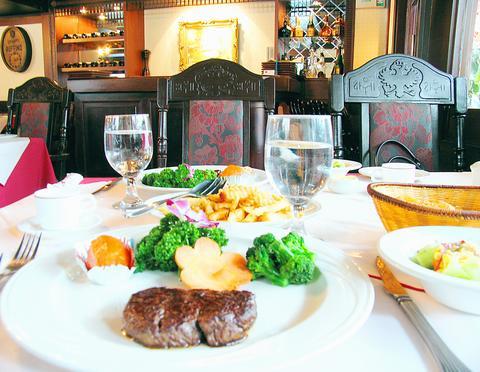Home Steak has been a fixture around Zhongxiao E Road for the past two decades -- and it shows. From the decor to the service, the restaurant is old-fashioned. This, it should be pointed out, is not a bad thing if it means good food, cooked in a traditional way, with attentive service.
The new Italian restaurant we had planned to review was, unaccountably, closed. They had said they were open daily from 12, but they weren't. Home Steak was nearby, it was a hot day, and it was cool inside. It turned out to be a good decision.

PHOTO: JULES QUARTLY, TAIPEI TIMES
The maitre'd was gracious and quick to find us a seat, even though it was busy and we hadn't reserved. Later, we wanted to move nearer the window and look out on the street and this was not a problem either.
Looking around, the wood paneling and high-backed chairs in a kind of Regency style complemented the freshly pressed dresses, suits and ties. In a town where casual is king, the more formal setting was quite refreshing.
Turning to the menu, there were some weighty items on the a la carte dinner list, in addition to the speciality steaks of the house. The lobster thermidor was a hefty NT$1,200, but anything cheaper and you would have to be suspicious. Grilled king prawns at NT$820 were recommended and the filet mignon with abalone was NT$1,050.
The best of the lunchtime picks are probably the set menus priced between NT$560 and NT$590. This comes with a choice of three soups, bread, a five ounce steak, ribs, or lamb, and coffee or tea afterward with a small slice of cake.
A nice touch was the vegetable fingers and a dip, which came while the food was cooking. The bread was warmed and not microwaved to death, which is just one of the faults of lower-end steakhouses. I asked for a well-done steak and it turned up just as I ordered, well presented, along with one of those little salad bowls that arrives drowned in thousand island dressing, regrettably too sweet and too much.
We also decided on French fries, which turned out to be crinkly chips. Though the purists will cringe, they were one of the best items on the menu with a dollop of ketchup. This is not to dismiss the steak, which was prime beef from the US, but will not be for much longer. Restrictions on US beef because of mad cow disease testing now means that scrupulous restaurant owners such as Home Steak will be getting their meat supplies from elsewhere, notably Australia. The lamb was from Scotland.
Overall, Home Steak was a pleasant experience and the waiters' obvious familiarity with many of their guests confirmed that this restaurant is a place to go back to.

On April 26, The Lancet published a letter from two doctors at Taichung-based China Medical University Hospital (CMUH) warning that “Taiwan’s Health Care System is on the Brink of Collapse.” The authors said that “Years of policy inaction and mismanagement of resources have led to the National Health Insurance system operating under unsustainable conditions.” The pushback was immediate. Errors in the paper were quickly identified and publicized, to discredit the authors (the hospital apologized). CNA reported that CMUH said the letter described Taiwan in 2021 as having 62 nurses per 10,000 people, when the correct number was 78 nurses per 10,000

As we live longer, our risk of cognitive impairment is increasing. How can we delay the onset of symptoms? Do we have to give up every indulgence or can small changes make a difference? We asked neurologists for tips on how to keep our brains healthy for life. TAKE CARE OF YOUR HEALTH “All of the sensible things that apply to bodily health apply to brain health,” says Suzanne O’Sullivan, a consultant in neurology at the National Hospital for Neurology and Neurosurgery in London, and the author of The Age of Diagnosis. “When you’re 20, you can get away with absolute

May 5 to May 11 What started out as friction between Taiwanese students at Taichung First High School and a Japanese head cook escalated dramatically over the first two weeks of May 1927. It began on April 30 when the cook’s wife knew that lotus starch used in that night’s dinner had rat feces in it, but failed to inform staff until the meal was already prepared. The students believed that her silence was intentional, and filed a complaint. The school’s Japanese administrators sided with the cook’s family, dismissing the students as troublemakers and clamping down on their freedoms — with

As Donald Trump’s executive order in March led to the shuttering of Voice of America (VOA) — the global broadcaster whose roots date back to the fight against Nazi propaganda — he quickly attracted support from figures not used to aligning themselves with any US administration. Trump had ordered the US Agency for Global Media, the federal agency that funds VOA and other groups promoting independent journalism overseas, to be “eliminated to the maximum extent consistent with applicable law.” The decision suddenly halted programming in 49 languages to more than 425 million people. In Moscow, Margarita Simonyan, the hardline editor-in-chief of the